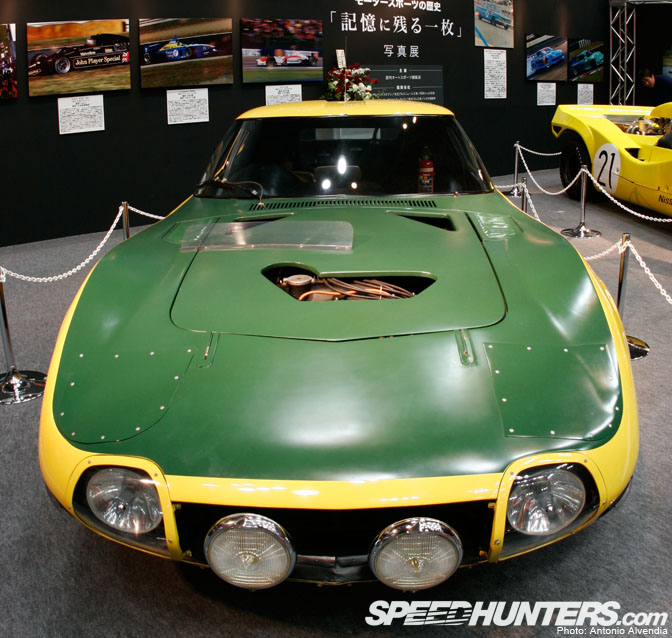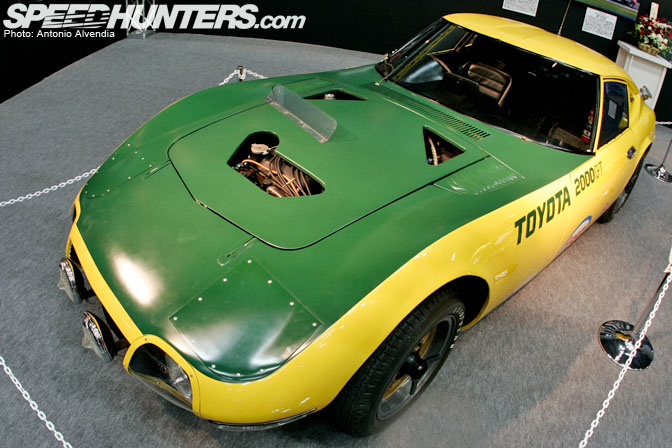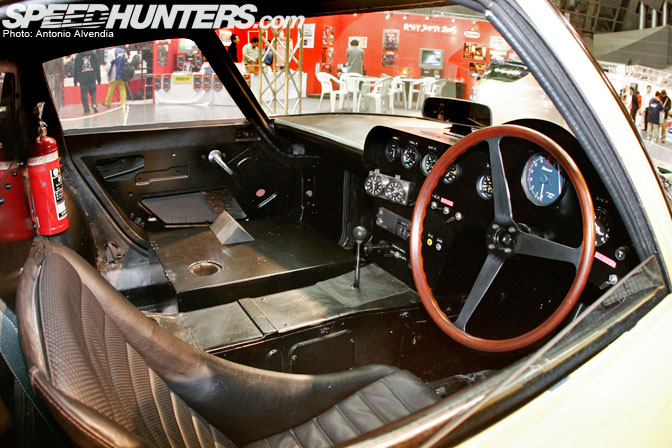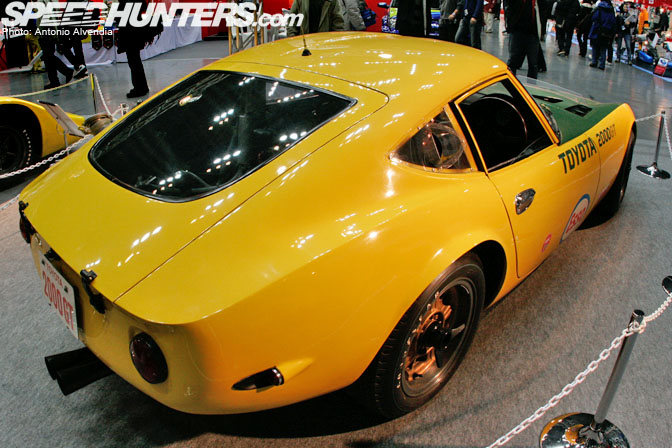
To start off our Toyota month, I wanted to put up these photos of the incredible Toyota 2000GT that was made famous for its top speed testing at the old (defunct) Yatabe Test Track, which is coincidentally really close to where Mike Garrett lives in Japan. When we were all together in Japan in August, Mike showed me and Rod where the remnants of the track were, and you can still see evidence of the banking and trees. They need to construct a Yatabe memorial there sometime.
Anyway, all the info in the story below was told to me about 6 months ago by my friend Ricky Silverio, who is a professional automotive encyclopedia. I don’t know how he does it, but this guy somehow manages to learn, index and retain automotive information in his head. He his an automotive style guru of many genres of car culture, who in my opinion, is always several years ahead of what other people are into.
I first spotted this MF10 Toyota 2000GT at Tokyo Auto Salon several years ago; these photos are from the 2004 or 2005 show. When I saw it, I was amazed that the famous green and yellow Toyota 2000GT was still around! Of course I’m a die hard Toyota fan, so I have seen old photos of this green and yellow 2000GT running the high banking of Yatabe from the 1960s. When I mentioned to Ricky that I saw and photographed the yellow and green Yatabe 2000GT, he corrected me. He said that the car I shot at Tokyo Auto Salon was actually a replica of the Yatabe 2000GT Land Speed Record car. The car in my photos is actually the 3rd Shelby 2000GT ever made. It was a development mule that was made into a race car in the summer of 1965. It was based on the prototype body, 280-A1. and was previewed at the 1965 Tokyo Motor Show. They made six cars from this same series; some of these prototypes were made out of steel, but some were made from hand beaten aluminum for light body weight.
THE REAL YATABE 2000GT
The real Yatabe car was destroyed several years ago. Ricky went on to explain that the real car was either the 2nd mule used for off site testing, or it was the prototype from the original Tokyo Motor Show. It wasnt hand-shapen aluminum bodied like the “racing prototypes” that were produced; it was actually steel. When it was originally built, it had Dunlop racing tires mounted on Dunlop magnesium wheels. Magnesium wheels are extremely lightweight, but they are also extremely flammable. The original Yatabe 2000GT caught on fire at Fuji Speedway during testing. However, the technicians at Toyota Technocraft and Toyota Sports Corner weren’t to be discouraged. After the 1966 Japan Grand Prix, they took the burnt shell of the 280-A1 2000GT and rebuilt it for the Yatabe time trial. After its runs at Yatabe, it’s rumored that the car got turned back into a circuit race car, and might have gotten burned in another wreck.
According to Ricky, whose family bought three 2000GTs when they were new in the 1960s, the car we see here was actually a “developmental mule,” or pre-production test car that Shelby American (yes, that Shelby. The one that produced the Shelby Cobra) in a previous life. Some devoted Toyota fans have seen photos of the red-and-white and blue-and-white Toyota 2000GTs that were developed by Carroll Shelby for Toyota’s racing efforts in the 1960s. Ricky explained to me that the primary red/white car was eventually turned back into a street car by Kearny Mesa Toyota, and that there was a third Shelby 2000GT, which was a pre-production “mule” painted lavender-and-white. This lavender-and-white 2000GT is what turned into the Yatabe yellow-and-green replica.
I was told that the only remaining mementos of this original lavender hued car were kept by an employee of Toyota. Rumor has it that he kept the purple headlight lids and knockoffs from the original Halibrand wheels. Shelby had Halibrand (the American musclecar wheel manufacturer) make the wheel 1 inch wider, but it still looked the same. The way to spot the wider Halibrand wheel is by locating a small mark on the wheel which says “Shelby/Halibrand.”

Since it’s not every day that most of us get to stare at a Toyota 2000GT, let’s take a look at some of the notable mods to this car. First off, obviously, is the yellow/green race paint. If you look closely, you’ll see that the yellow paint is shiny and polished, whereas the green portion has a satin finish (not flat – it is NOT primer). The factory lights were replaced with higher output Lucas lights in the bumper and some high end SEV Marchal foglights. The car builders decided to blank out the OEM retracting headlights, presumably for weight reduction.
Check out the oddly shaped cutouts in the hood. Those weren’t cut out for aerodynamic reasons. The Toyota Technocraft engineers cut holes in the hood to allow for checking/changing the vital fluids without opening the hood;
this was done so they could do everything quickly – without popping the hood open during pit
stops. Extra holes and louvers were made towards the rear of the hood so that the heat could escape from the
engine bay quickly. Notice also the clear acrylic bug deflector on the hood! Do any of you Supra guys recognize the hood cutouts? They’re in pretty much the same positions as the holes in the TRD 3000GT Supra aero kit.
For engine mods, the OEM Mikuni/Solex carburetors were replaced by triple Weber carbs, making 300hp at 7200rpm. The final drive gear was changed to accomplish a top speed of 130.5mph in top gear (4th).
As you can see from the sponsor logos outside the car, Esso and Nippondenso are the car’s primary sponsors. The real Yatabe test car
had Goodyear Blue Streak racing tires and Dunlop magnesium racing
wheels. The replica had the Shelby/Halibrand wheels with Goodyear tires, because Halibrand was the original wheel brand used on the original Shelby prototype car.

Check out the cool looking interior of the car. It reminds me of a much older version of a Super GT cockpit, with the gauges/instrumentation and sheetmetal panels covering the transmission and other parts of the car. Notice the wingless-backed bucket seats. I don’t think those could possibly hold a driver in his place successfully, because of the relative lack of side bolstering. They look super cool though!
The Toyota 2000GT prototype originally debuted at the 1965 Tokyo Motor Show. or 66. From that first prototype, they made four cars. One
became the Yatabe test car, and the other two became circuit racing cars that
raced in the third Japanese Grand Prix. The year was 1966. The Yatabe test car ran in the FIA sanctioned Yatabe Speed Trials on October 1st, 1966. With this car, Toyota won sixteen international land speed and endurance records over
the course of the event. They were running the car for 2 days straight, competing in the 6 hour class, 12 hours, 24, 48, and 72 hour classes of straight up testing..
The car was driven by Shinonome Hosoya, Hiroshi Fushida,
Mitsuo Tamura, and Sachio Fukuzawa He was one of the first Japanese superstar drivers back then; he regularly appeared
in fashion mags and stuff.

If you look closely, you’ll see the Halibrand wheels, knockoffs, and Goodyear tires, as I mentioned previously. This 2000GT was also equipped with a quick fill gas tank, which holds 31.7
gallons. If you look into the left rear passenger quarter window, they put a quick change
system for the trans and diff oil, with remote fillers.
On the other side, the right rear quarter window had a vent to suck air into the interior. What an incredible car, with incredible details, all told to me over the phone several months ago by Ricky Silverio. Crazy.
-Antonio Alvendia






Wow. Stunning. Interesting history too. Great write-up.
Great story, I think the 2000GT will always be my favorite old school car.
Is that the same silverio that helped the 2 guys who own the orange Celica and orange Corolla that were featured in the first Japanese Nostalgic Car magazine? That Silverio was told to be a nostalgic nut too who inspired and helped those 2 build the orange rides. Just read that the other day. Cool feature Antonio!
DUde, how sick would a 2000GT look with "proper" offset 17x9.5's. Oh dang!
First off, DAAAMN !!! I'm a brand new fan of this website, cause you people get new articles soo fast!! And great quality! Great articles, great videos, great, great, great! Only that I can't login anymore though I just created a account:-w Still waitting for that mail from you guys... Anyway... This is a great story as well!!! That dude Ricky sure is weird, in a good way though. It must mean that he's a great automotive fan on a totally different level, as into max-obsessed! You need that to have the patience and ability to analize, memorize and index all that info. Anyway Great story!! Keep it up !!!:D
i didn't know that the 2000GT's code was MF10, thats probably the reason why Lexus has taken the F for its sport models.
hechtspeed: same guy. he is one of the biggest influences i had, as i was growing up (in terms of my automotive tastes). he is also a behind the scenes consultant/judge for the Motoring J Style show. that guy knows what's up.
way to get that engine bay shot !
Great history on the most beautiful Japanese car ever made! Old school vs. new school-- old school wins every time! Any more shots of the wheels? I never knew Shelby worked with Toyota!!! I'm going to do a Google image search right now on those!
This Rick Silverio is a legend the way you put it, Antonio..
Sweet story Antonio!
I gotta tell you from experience, that the 2000GT is a fun car, especially at night on the streets of Yokohama and Tokyo!
Motorsport is a funny way to make a living, driving round and round in circles, faster and faster if